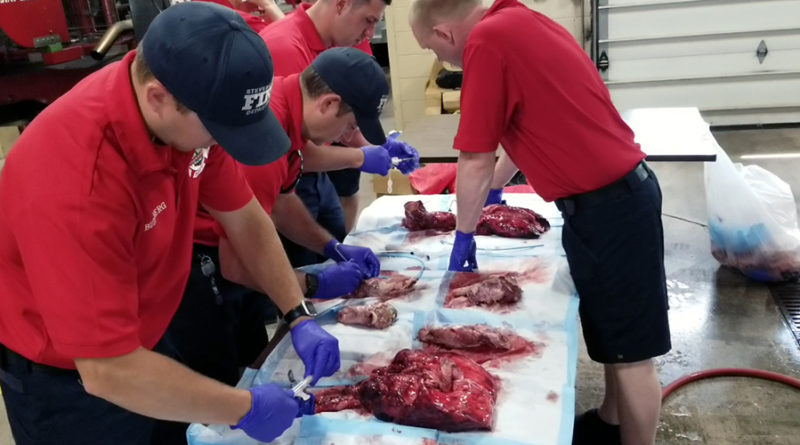Lifelike scenarios provide better training for local paramedics
By Brandi Makuski
The manikin on the training table at Stevens Point Fire Dept. had an unsettling appearance: his eyes dilate and blink; he has a pulse in all the same places as a human. He has all the same heart, bowel and breath sounds.
He wheezes, cries in pain, and calls for help.
Meet Apollo. Named after the Greek god of the sun, he can mimic just about any medical condition paramedics might encounter. He’s a new tool available for paramedic training, courtesy of Mid-State Technical College.
“It’s one of the neatest things I’ve seen for training purposes,” said SPFD Assistant EMS Chief Joe Gemza. “A lot of these procedures can’t be performed on a regular manikin.”
Apollo was one of two specialized manikins visiting SPFD for intubation training on May 25. The other was a special “intubatable” manikin head with the ability to simulate vomiting (typically comprised of soup, pre-loaded into the stomach cavity by instructors), a common reaction when paramedics place a breathing tube down a patient’s throat.
“Paramedics have to try to clear it out, suction it, and then intubate,” said Ryan Huser, a paramedic instructor at MSTC. “Unfortunately, that happens a lot. It’s something they realistically have to deal with. We don’t intubate every single day, but it’s a high-risk maneuver, so we like to stay on top of it.”
Huser said a movement with renewed traction in the world of emergency medical services is the “Do it for Drew” campaign, which highlights the need for better, and more frequent, training on intubation techniques. The campaign is named for Drew Hughes, a 13-year-old from North Carolina who was rendered unconscious during a skateboard accident and died after a breathing tube was improperly placed in his throat en route to the hospital in 2013.
Keith Melvin, who teaches EMS simulations for MSTC, said Apollo’s limbs and skin have been removed to simulate injuries from various vehicle and farming accidents. Not long ago, he said, Apollo’s neck was broken after being hung in a jail cell during an inmate scenario for corrections officers at a local law enforcement facility.
Thanks to special hidden compartments in the 160-pound dummy, he even bleeds and urinates, should a medical condition call for it.
“It’s all designed to react the way a real patient would in real situations,” Melvin said. “Paramedics typically don’t work in a clean emergency room; we’re outside in swamps, in ditches, in the dirt. So Apollo can be outside, in those elements when we train on him.”
Apollo costs $86,000 and was paid for with a federal grant. His female counterpart, “wife” Lucina—named for the Greek goddess of childbirth—costs $120,000 and comes with the ability to simulate birth. Both run on a seven-hour battery, have hidden containers that hold simulated body fluids, and have built-in wifi hot spots.
A nearby computer tracks the medical care provided to each; following the procedure, Huser said, electronic reports are used to discuss the results for each scenario, and what, if anything, could have been done differently.
On Friday, Apollo played a lifeguard suffering anaphylactic shock. Melvin was able to manipulate Apollo’s physical body to simulate a common reaction to a series of wasp stings, including altered blood pressure and pulse, and a swollen tongue and airway.
“He was created to train anesthesiologists, so it gives you the worst-case patient scenario,” Melvin said. “The swollen tongue makes it hard to tube a patient. His vitals will change on its own depending on what the paramedics to do him.”
“This changes the whole game for us in paramedic education,” Gemza said. “It’s very different from a PowerPoint presentation, and it really helps to keep our skills fresh.”
More information on the MSTC EMT-Paramedic program can be found here.
Editor’s Note: A previous version of this story incorrectly listed Mr. Huser’s first name. The story has been corrected.


